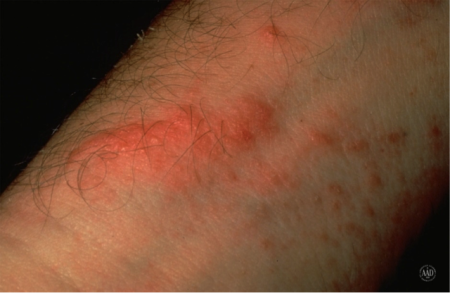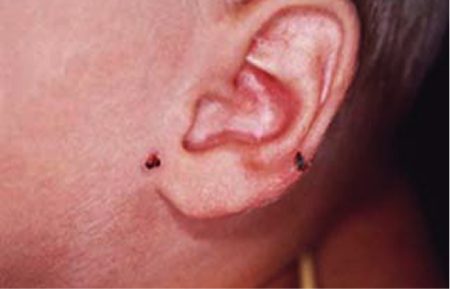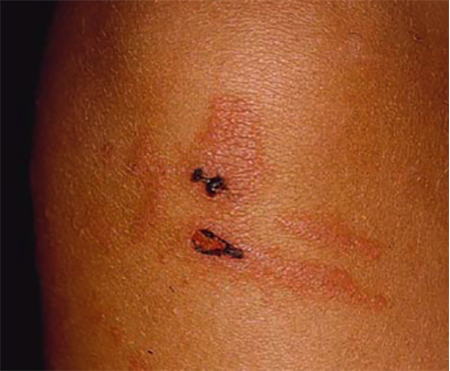In some cases, a person may experience localized swelling. The severity of the rash and the intensity of the itching will differ depending on the person.
How to recognize and treat poison oak rash
All parts of the poison oak plant contain an oil called urushiol. If a person touches the plant or comes into contact with the oil in some way, it can trigger the body’s immune system and produce a rash.
According to the American Academy of Dermatology Association (AAD), the leaves, stems, flowers, roots, and vines of the poison oak plant contain urushiol.
Between 80–90% of people will develop a rash when they come into contact with 50 micrograms of urushiol. This amounts to fewer than one grain of table salt.
A person can come into contact with the oil via touching the plant or anything that has come into contact with it, such as pets, tools, or clothing. If someone is burning the plant nearby, a person can also inhale the oil.
This article discusses what a poison oak rash looks like. It also looks at the treatment options available, how to identify poison oak, and how a person can help prevent the rash.
People can develop an allergy to the oil, leading to a rash referred to as allergic contact dermatitis.
People who are allergic to the oil do not have a reaction until they come into contact with it for a second time. The immune system learns to recognize the oil from the first contact and then reacts to it aggressively on future contact.
The rash appears where the oil has come into contact with the skin.
The AAD notes that a person can expect the following:
- An intense itch at the area where the rash will appear.
- An itchy, blistering rash that appears shortly after the itching begins.
- Blisters that may open and leak before crusting over.
In some cases, a person may experience localized swelling. The severity of the rash and the intensity of the itching will differ depending on the person.
The rash will resolve within 2–3 weeks.
When will a poison oak rash appear?
The AAD states that if a person has never experienced a poison oak rash before, it may take 2–3 weeks to appear.
If a person has developed a poison oak rash in the past, the current one will appear within 4–48 hours.
How long does a poison oak rash last for?
The rash should settle down and begin healing, even without treatment.
According to the AAD, if a person has experienced a rash from poison oak in the past, it can take 1–14 days to resolve. For those who have never had a poison oak rash, it can last for 21 days or more.
If a person thinks they have come into contact with poison oak, they should:
- Wash the skin immediately using:
- dishwashing soap
- laundry detergent
- poison oak cleanser
- rubbing alcohol
If a person does this within 10–20 minutes after coming into contact with the plant, they may be able to help prevent a rash from forming.
Home remedies
According to the Food and Drug Administration (FDA) , ways to soothe the rash and help prevent it from getting worse include applying:
- a wet compress
- over-the-counter (OTC) topical corticosteroids, such as hydrocortisone cream
- OTC lotions, such as calamine, or those that contain:
- aluminum acetate
- zinc carbonate
- zinc oxide
- zinc acetate
A person may also find it beneficial to soak the rash in cool water or take a lukewarm bath containing colloidal oatmeal.
People should avoid scratching the rash as bacteria from their nails may lead to infection.
Medication
According to the National Institute for Occupational Safety and Health (NIOSH) , antihistamines, such as diphenhydramine, can ease the itching.
A doctor can prescribe oral or topical steroids or strong antihistamines.
According to the AAD, there are several reasons a poison oak rash may appear to spread.
One reason is that there is a short window of time where a person may be able to accidentally spread the oil from one part of their body to another. This can cause a rash to develop near the original rash, giving the appearance that it is spreading.
Alternatively, the oil can spread from a person’s clothes onto their skin, causing a rash to appear on parts of the body that did not touch the plant.
In addition, the rash will develop first on the area of skin that has the most oil on it. Skin exposed to less oil may react later on.
Ways that a person can help prevent the spread of the oil include:
- wearing protective gloves when removing clothes that may have come into contact with the oils
- washing clothes as soon as possible on a hot wash and with detergent
- cleaning all tools with rubbing alcohol or soap
The rash is not contagious. But it is possible to spread the oil to others. Urushiol will often stick to clothing, garden tools, and other items that have come into contact with the poison oak.
A person may also come into contact with the oil when touching an animal’s fur if it has been near the plant.
People should wear protective gloves when bathing their pets if they think their pet has been around poison oak or other poisonous plants.
Recognizing the actual plant is challenging because individual poison oaks come in different forms. The FDA states that it grows in the Eastern and Southern United States.
Poison oak is a low shrub with fuzzy green leaves that appear in clusters of three. The edges may have rounded tips or pointed tips. Berries that are yellowy-white in color may also be present.
To help a poison oak rash from developing, a person should:
- Wear clothing that covers the skin, such as long sleeves, boots, socks, and gloves.
- Apply an ivy blocker to the skin.
- After being outside:
- machine-wash any clothing
- clean any tools using rubbing alcohol or soap with water
- wash any pets, as fur can carry the oil
People should also avoid burning or mowing the plant, as this can release its oils into the air.
People whose work puts them at a higher risk of contact with poison oak oil need to take measures to protect themselves. Employers must also help.
The NIOSH has tips for workers who come into contact with poisonous plants.
These include suggestions such as:
- wearing long sleeves, long pants, boots, and gloves to ensure that as little skin as possible is exposed
- washing any clothes exposed to poisonous plants in hot water, with detergent, and not with any other clothes
- using barrier creams where necessary to protect the skin
- thoroughly cleaning any tools that may come into contact with urushiol using rubbing alcohol or soap and lots of water
- avoiding burning poisonous plants, as inhaling the smoke from these plants may cause a person to experience severe respiratory allergies
Any swelling beyond small hives in the affected area indicates that a person should contact a doctor.
The FDA recommends people contact a doctor about their rash if they experience:
- a temperature over 100ºF
- pus or yellow scabs on the rash
- tenderness around the rash
- itching that causes people to wake up or worsens at night
- difficulty breathing
- no improvement in the rash after a few weeks
- a rash that spreads to the genitals, mouth, or eyes
- a rash that covers more than a quarter of the skin
- a widespread rash
Severe allergy
People should call for immediate medical help or go to an emergency room straight away if they experience:
- swelling around the eyes, face, lips, or tongue
- any effect at all on swallowing or breathing
- a strong feeling of being unwell
- signs of infection, such as spreading redness, pus, or pain
- headache
- swollen lymph nodes
Other causes of rashes that may look similar to poison oak rash include:
- Other plants: Poison ivy and poison sumac also release urushiol when they become damaged, bruised, or burned.
- Ringworm: This occurs due to a fungus that feeds on keratin, which is a protein in the skin. It causes itchy skin and a ring-shaped rash on the body. Unlike poison oak, it is contagious .
- Psoriasis: This is an autoimmune condition that may cause a person to experience a rash, which can vary depending on the type of psoriasis a person has.
- Eczema: This is the name of a group of conditions that cause itchy rashes as a result of a combination of genetic factors and environmental triggers. Similar to poison oak rash, this is not contagious.
When damaged, bruised, or burned, poison oak releases an oil called urushiol that can cause a person to develop an itchy, blistered rash. The rash will typically resolve itself without treatment, but may be uncomfortable and intensely itchy until it has gone away.
People who work in areas that have these plants may have an increased risk of coming into contact with the oil and developing the rash.
People can often manage the symptoms of a poison oak rash using home remedies or OTC treatment options. But if the rash does not resolve, they should seek medical advice.
A person experiencing symptoms of a severe allergic reaction should immediately seek medical help.
Last medically reviewed on December 9, 2021
How we reviewed this article:
Medical News Today has strict sourcing guidelines and draws only from peer-reviewed studies, academic research institutions, and medical journals and associations. We avoid using tertiary references. We link primary sources — including studies, scientific references, and statistics — within each article and also list them in the resources section at the bottom of our articles. You can learn more about how we ensure our content is accurate and current by reading our editorial policy.
- Allergens: Poison ivy/poison oak/poison sumac. (n.d.).
https://www.hopkinsmedicine.org/health/conditions-and-diseases/allergens-poison-ivy–poison-oak - How ringworm spreads. (2021).
https://www.cdc.gov/fungal/diseases/ringworm/sources.html - Outsmarting poison ivy and other poisonous plants. (2021).
https://www.fda.gov/consumers/consumer-updates/outsmarting-poison-ivy-and-other-poisonous-plants - Poison ivy, oak, and sumac. (n.d.).
https://www.aad.org/public/everyday-care/itchy-skin/poison-ivy - Poisonous plants: Recommendations. (2018).
https://www.cdc.gov/niosh/topics/plants/recommendations.html - What is eczema? (n.d.).
https://nationaleczema.org/eczema/ - What is psoriasis? (2020).
https://www.cdc.gov/psoriasis/
Share this article
Poison ivy, oak, and sumac: What does the rash look like?
While rare, some people see black spots instead of a red rash on their skin. These spots look like black lacquer spilled onto the skin. Instead of black spots, some people develop black streaks on their skin.
If you develop black spots or streaks, there tends to be little or no redness and swelling. The medical term for this condition is black-spot poison-ivy dermatitis.
Poison ivy rash
A rash from one of these poisonous plants usually shows up as red, itchy bumps on the skin.

Black-spot poison-ivy dermatitis
A few people develop black spots or streaks of black on their skin rather than a red rash.

Poison ivy rash: Streaks and spots
This 7-year-old boy developed red streaks and black spots.

How does the rash show up on the skin?
It takes time for the rash to appear. A rash can develop in a few hours if you’ve had a rash from one of these plants before. If you’ve never had a rash from poison ivy, oak, or sumac, it can take 2 to 3 weeks before you see a rash.
No matter how long it takes for the rash to appear, most people experience the following when they get a rash:
- The skin itches intensely where the rash will appear. The itch can be so intense that it wakes you from a sound sleep.
- Shortly after your skin starts to itch, the rash appears. Most people develop an itchy, red, and blistering rash.
- If you have blisters, they break open and leak fluid.
- The blisters crust over, and the rash clears in 2 to 3 weeks. The rash will clear without treatment, but it can be extremely itchy until it clears completely.
The intensity of the itch and severity of the rash can differ from person to person. Some people develop 1 or 2 small rashes. Others develop rashes all over.
Why does the rash from poison ivy, oak, or sumac spread?
While it may look like the rash is spreading, what’s most likely happening is that you’re developing one or more new rashes. This happens because you either:
- Got urushiol (the oil from these plants that causes the rash) on more than one area of your skin. Typically, the skin with the most oil on it develops a rash first. Skin with less oil tends to react later.
- Touched something that still has urushiol on it, such as the unwashed clothing you were wearing when you brushed up against one of these poisonous plants. Urushiol doesn’t have to be on the plant to cause a rash.
If your new rash appears near the current rash, it can look like the rash is spreading.
Many people also mistakenly believe that when they touch their rash, they can spread the rash from one part of their body to another. You cannot spread the rash.
If you have oil from the plant on your skin, you can spread the oil for a short time. Your skin absorbs the oil quickly, so you can only spread the oil from one part of your skin to another for a short amount of time.
How long does a rash from poison ivy, oak, or sumac last?
How long you have a rash depends on whether you’ve had a rash from one of these plants before. Here’s the general rule:
- Previous rash from poison ivy, oak, or sumac: The rash tends to last 1 to 14 days before it clears on its own.
- Never had a rash from poison ivy, oak, or sumac: You can have a rash for 21 days or longer before it goes away.
If you’re wondering why you develop a rash from these plants, you’ll find the answer at: Poison ivy, oak, and sumac: Who gets a rash, and is it contagious?
Images
Image 1 used with permission of the American Academy of Dermatology National Library of Dermatologic Teaching Slides.Images 2,3 used with permission of the Journal of the American Academy of Dermatology.
- J Am Acad Dermatol 2001;45:246-9.
References
Kurlan JG, Lucky AW. “Black spot poison ivy: A report of 5 cases and a review of the literature.” J Am Acad Dermatol 2001;45:246-9.McGovern TW. “Dermatoses due to plants.” In: Bolognia JL, et al. Dermatology. (second edition). Mosby Elsevier, Spain, 2008: 255-6.
- About AAD
- Contact AAD
- Donate
- Employment
- Store
- Support AAD
- Website feedback
- AAD meetings & events
- Advertise
- Classifieds
- Licensing
- Mailing lists
- Meeting advertising
- Legal notice
- Corporate partners
- Donors
- Exhibitors: 2023 Annual Meeting
- Media
- International
- For AAD members
- Patient advocates
- Diseases & conditions
- Everyday care
- Cosmetic treatments
- Public health programs
- Find a dermatologist
Reproduction or republication strictly prohibited
without prior written permission.





